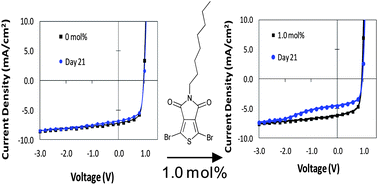Organic solar cells have attracted wide interest in the scientific community as a possible alternative for silicon based photovoltaics in certain areas. While laboratory efficiency of organic devices went beyond 10 % within the last years, lifetime issues such as rapid performance degradation remain to be solved.
In a recent article, Mateker et al. examined the performance degradation of solar cells made of the commonly used polymers PBDTTPD and PC61BM. Earlier findings indicated that cells made with PBDTTPD of high average molecular weight (Mw) degraded even in inert atmosphere and darkness while those of low Mw did not.
By intentional contamination with the small molecule TPD, the researchers demonstrated the influence of such impurities onto device performance. As a consequence, high weight PBDTTPD was thoroughly purified. Devices utilizing this filtered polymer demonstrated shelf lifetimes beyond 111 days.
The performance reduction of the unfiltered high Mw polymer is attributed by the researchers to small molecules which form a layer at the cathode contact of the cell. This layer was indicated by the widely known S-shaped JV-characteristic. Such features are developed within less a week of storage in darkness. By removing the old and evaporating a new cathode layer, device performance was partially recovered and the standard solar cell JV-curve shape was re-established.
Intentional introduction of TPD (a building block of PBDTTPD and thus a possible residue of the synthesising reactions) into the low Mw polymer created the same behaviour as for the unfiltered high Mw counterpart. In consequence, the authors removed small molecule impurities from the high Mw polymer by size exclusion chromatography (SEC) and demonstrated the excellent improvement of device lifetime.
Read more detail in the article:
Improving the long-term stability of PBDTTPD polymer solar cells through material purification aimed at removing organic impurities
William R. Mateker, Jessica D. Douglas, Clément Cabanetos, I. T. Sachs-Quintana, Jonathan A. Bartelt, Eric T. Hoke, Abdulrahman El Labban, Pierre M. Beaujuge, Jean M. J. Fréchet and Michael D. McGehee
DOI: 10.1039/C3EE41328D
By Sebastian Axmann











